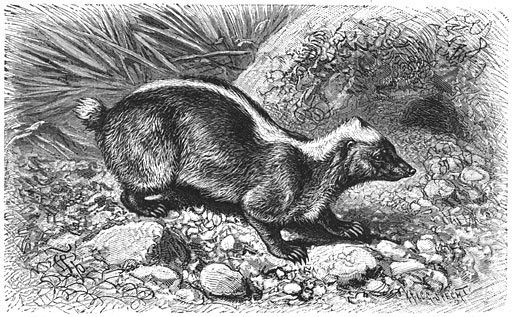Mydaus on:
[Wikipedia]
[Google]
[Amazon]

 Stink badgers, also known as false badgers are a genus (''Mydaus'') of the skunk family of carnivorans, the Mephitidae. They resemble the better-known members of the family Mustelidae also termed ' badgers' (which are themselves a polyphyletic group). There are only two extant species – the Palawan stink badger or ''pantot'' (''M. marchei''), and the Sunda stink badger or ''teledu'' (''M. javanensis''). They live only on the western islands of the Greater Sunda Islands:
Stink badgers, also known as false badgers are a genus (''Mydaus'') of the skunk family of carnivorans, the Mephitidae. They resemble the better-known members of the family Mustelidae also termed ' badgers' (which are themselves a polyphyletic group). There are only two extant species – the Palawan stink badger or ''pantot'' (''M. marchei''), and the Sunda stink badger or ''teledu'' (''M. javanensis''). They live only on the western islands of the Greater Sunda Islands:
Stink badgers were traditionally thought to be related to Eurasian badgers in the

 Stink badgers, also known as false badgers are a genus (''Mydaus'') of the skunk family of carnivorans, the Mephitidae. They resemble the better-known members of the family Mustelidae also termed ' badgers' (which are themselves a polyphyletic group). There are only two extant species – the Palawan stink badger or ''pantot'' (''M. marchei''), and the Sunda stink badger or ''teledu'' (''M. javanensis''). They live only on the western islands of the Greater Sunda Islands:
Stink badgers, also known as false badgers are a genus (''Mydaus'') of the skunk family of carnivorans, the Mephitidae. They resemble the better-known members of the family Mustelidae also termed ' badgers' (which are themselves a polyphyletic group). There are only two extant species – the Palawan stink badger or ''pantot'' (''M. marchei''), and the Sunda stink badger or ''teledu'' (''M. javanensis''). They live only on the western islands of the Greater Sunda Islands: Sumatra
Sumatra is one of the Sunda Islands of western Indonesia. It is the largest island that is fully within Indonesian territory, as well as the sixth-largest island in the world at 473,481 km2 (182,812 mi.2), not including adjacent i ...
, Java, Borneo in Indonesia, Malaysia and Brunei and (in the case of the Palawan stink badger) on the Philippine island of Palawan; as well as many other smaller islands in the region.
Stink badgers are named for their resemblance to other badgers and for the foul-smelling secretions that they expel from anal glands in self-defense (which is stronger in the Sunda species).Stink badgers at the Badger PagesStink badgers were traditionally thought to be related to Eurasian badgers in the
subfamily
In biological classification, a subfamily (Latin: ', plural ') is an auxiliary (intermediate) taxonomic rank, next below family but more inclusive than genus. Standard nomenclature rules end subfamily botanical names with "-oideae", and zoologi ...
Melinae of the weasel family of carnivorans (the Mustelidae), but recent DNA analysis indicates they share a more recent common ancestor with skunk
Skunks are mammals in the family Mephitidae. They are known for their ability to spray a liquid with a strong, unpleasant scent from their anal glands. Different species of skunk vary in appearance from black-and-white to brown, cream or ginge ...
s, so experts have now placed them in the skunk family (the Mephitidae, which is the sister group
In phylogenetics, a sister group or sister taxon, also called an adelphotaxon, comprises the closest relative(s) of another given unit in an evolutionary tree.
Definition
The expression is most easily illustrated by a cladogram:
Taxon A and t ...
of a clade
A clade (), also known as a monophyletic group or natural group, is a group of organisms that are monophyletic – that is, composed of a common ancestor and all its lineal descendants – on a phylogenetic tree. Rather than the English term, ...
composed of Mustelidae and Procyonidae
Procyonidae is a New World family of the order Carnivora. It comprises the raccoons, ringtails, cacomistles, coatis, kinkajous, olingos, and olinguitos. Procyonids inhabit a wide range of environments and are generally omnivorous.
Character ...
, with the red panda also assigned to one of the sister clades). The two existing species are different enough from each other for the Palawan stink badger to be sometimes classified in its own genus, ''Suillotaxus''.
References
{{Taxonbar, from=Q1507049 Mephitidae Carnivorans of Malaysia Mammals of Brunei Mammals of Indonesia Mammals of the Philippines Taxa named by Frédéric Cuvier